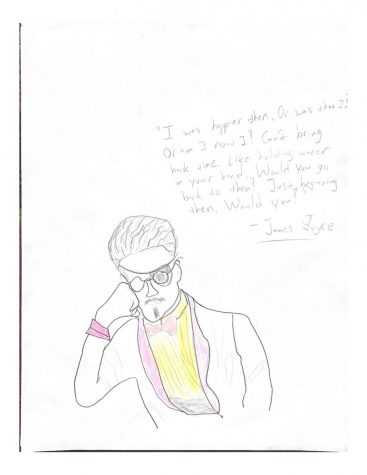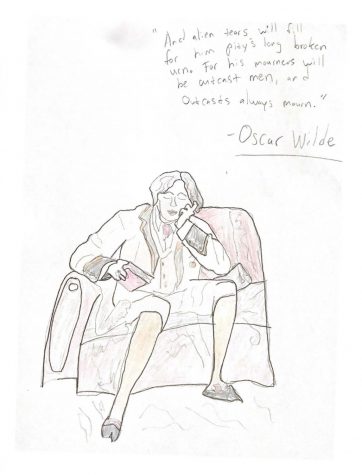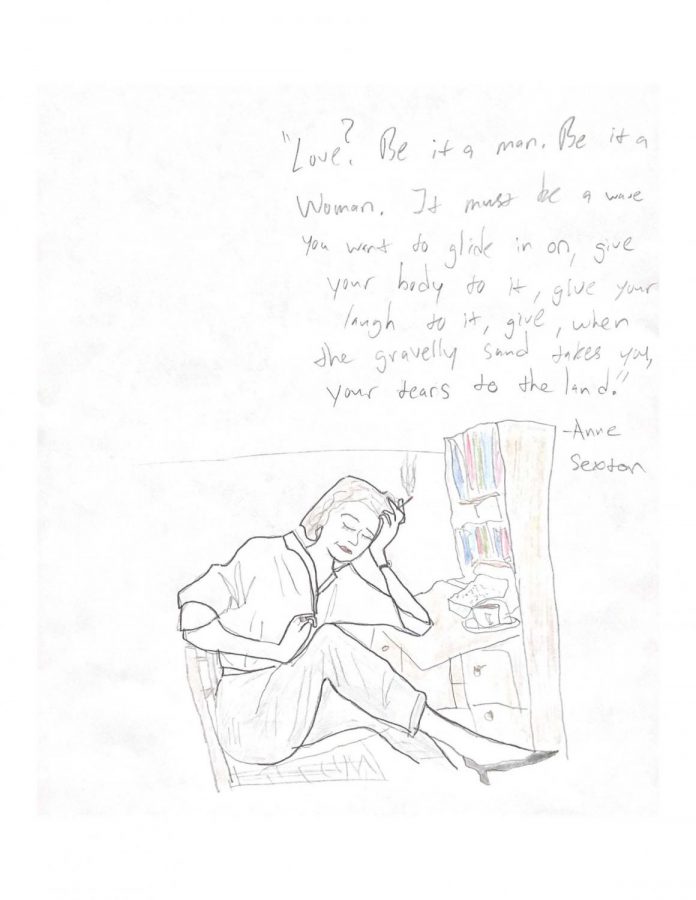A Raunchy Romp Through Literature
May 12, 2020
Entering that balmy room on the fifth floor of the Rue de Montreuil from the novel cold always proved uncomfortable. My glasses fogged and my face warmed to a horribly Celtic shade of carmine. Evé Tournier’s, with whom I shared an odd relationship at the time, brown-back was bare and showcased the fresh ink of the Eastern-style dragon she had capriciously gotten tattooed three days beforehand, somewhere in the Parisian suburbs. Removing my glasses, I regarded her in my half-vision and placed, what I believed to be, white wine on the kitchen counter. I checked my father’s wristwatch — only four hours left in 2018.
Touriner sat hunched over my recently purchased copy of “Une Saison en Enfer (A Season in Hell)” by Arthur Rimbaud. She turned to me and uttered in thick, tivid words, “How he paints his sins! How he speaks of Satan! Cher Satan (Beloved Satan).”
This refrain, charming in its reverent decadence, proposed a question, daunting and intriguing, which persisted unanswered until 2020 — how did these writers write about their sins, especially those of a sexual nature and how do they now?
“I think every generation of writers approaches it slightly differently than the preceding,” said Alvin Orloff, employee of Castro’s Dog Eared Books. Orloff believes that the current vogue is to treat sexuality as a matter of fact. “Not sensationalized as opposed to back in the 1990s [when] everyone wanted to be edgy. I think that the pendulum has swung about as far as they can go in the opposite direction and people aren’t really interested in [sexual sensationalism], they’re interested in just sort of integrating it into their everyday.”
Boston-based writer, Amittai F. Aviram, Ph.D., discusses the generational literary approach toward sex in the literary movement of French Symbolism in his essay, “Rimbaud: Sex, Verse, and Modernity.” Wherein he states that libertine poet Arthur Rimbaud, along with many of his symbolist contemporaries, such as Charles Baudelaire and Paul Verlaine (with whom Rimbaud shared a violent, sexual relationship), worked within a burgeoning literary sphere that sought to philosophize sensuality and sexual desire.
“[To] cross the biggest metaphysical gulf of all, that between “l’esprit et les sens (Spirit of the Senses)” Aviram writes. “Between nature and consciousness — between the innocently necessary and the morally troubled, they must perforce demonstrate that the orders of the senses correspond so closely with each other as to give rise to a magically charmed synaesthesia.”

Aviram also states that the written technical manner in which sexual topics were discussed within Symbolism also expressed a certain level of literary radicalism. Whether those techniques present are deliberately dissonant poetic images or meters, or as in the case of Baudelaire, mythological or created figures being used as a mechanism to discuss and understand sex by standing for its voice.
“In Rimbaud’s poems, as in poetry generally, imagery reflects upon the power of rhythm” writes Aviram. “Like the reflective noyé pensif (thoughtful drowned man) … it is already afloat in rhythm and must give way to its powerful unimaginary currents. It is in this way that Rimbaud’s poems offer a truly radical sexual politics by means of its revolutionary poetics.”
Summer Star, Ph.D., professor of literature at San Francisco State, discussed how the radical approch of the Symbolists to sex held long-lasting effects for future literary movements.
An echo of the Symbolists can be heard within Irish playwright Oscar Wilde’s 1840 novel, “The Picture of Dorian Gray.” A novel considered the zenith of literary Aestheticism, Star said.
The novel was seen as an assault on the prevalent repressive morals of Victorianism. The novel, released in chapters in Lippincott’s Monthly Magazine, was heavily censored and controversial leading Wilde to write a preface to the novel upon its full publication, addressing the controversy surrounding the work. According to Harvard University Press, British critics described the work as, “vulgar, unclean, poisonous, discreditable and a sham.” As the original uncensored text featured explicit references to homosexuality/bisexuality.
“The vast majority of Stoddart’s deletions were acts of censorship, bearing on sexual matters of both a homosexual and a heterosexual nature,” The Harvard Press wrote in their article “A Textual History of The Picture of Dorian Gray.” “Much of the material that [Lippincott’s Monthly Magazine’s editor] Stoddart cut makes the homoerotic nature of Basil Hallward’s feelings for Dorian Gray more vivid and explicit than either of the two subsequent published versions, or else it accentuates elements of homosexuality in Dorian Gray’s own make-up. But some of Stoddart’s deletions bear on promiscuous or illicit heterosexuality too.”
The preface, a manifesto of Aestheticism, is in many respects reminiscent of the Symbolist’s desire to meld spirituality and sexual sensuality.
“Vice and virtue are to the artist materials for an art … Diversity of opinion about a work of art shows that the work is new, complex, and vital,” Wilde writes.

The novel itself also alludes directly to the french symbolists in Chapter 10. During one of the book’s most self-referencial moments, the titular protagonist, Dorian Gray, reads a “poisonous book” that Wilde intimates is not dissimilar to the one the reader is presently reading.
“Technical expressions and elaborate paraphrases that characterized the work of some of the finest artists of the French school of Symbolistes,” Wilde wrote. “The life of the senses was described in the terms of mystical philosophy. One hardly knew at times whether one was reading the spiritual ecstasies of some medieval saint or the morbid confessions of a modern sinner.”
This trend in explicit sexual discourse and thematics persisted to the Modernists of the early 20th century. Although, as with the Aesthetes, Modernist content was typically viewed as obscene by critics, according to the article “Changing Views of Sexuality In the Modernist Era”
published by Keene State College, sex and sexuality remained a “a consistent topic nonetheless.”
“Early modernist novels were obsessed with escaping from the confines of society’s expectations of relationships,” Keene State College wrote. “Virginia Woolf wrote stories which explicitly include sexuality (although it may not be the focus) including “To the Lighthouse,“”Between the Acts,” “Mrs. Dalloway” and “Orlando.”
Editor note: The original post of this story was out of date. This new post has been accordingly updated with the final version of the story.






